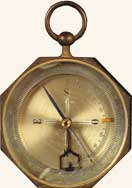 | |
| N. Roerich’s compass |
Behind Karakorum, ancient Asian desert of Taklamakan started. They crossed the Chinese border. The expedition caravan was following the Great Silk Way. When they were approaching Hotan, Nicholas Roerich was warned of the local authorities’ rudeness and despotism. But the Roerichs could not avoid this city.
In Hotan, having picked at the Roerichs’ Chinese passport, they actually arrested the expedition. They took away their weapons, prohibited to conduct scientific work and paint. “We must manage to leave. Despite the frost, we must go”19, the artist wrote down.
It was the help of the Soviet Consul in Kashgar, who responded to Roerich’s letter, that worked. He took measures, and, at the end of January 1926, the expedition left Hotan. Now, the way was to go North, where, behind the spurs of Celestial Mountains of Tian Shan, the Russian land lay. “The bells on the camels are of different sizes and sound like a whole symphony. This is an unforgettable melody of desert. <…> the symphony of bells, tender like ancient bronze, and regular, like the movement of the ships of desert”20.
 | |
| N., H., and G. Roerichs with workers
of the Soviet Consulate in Urumchi. 1926 | |
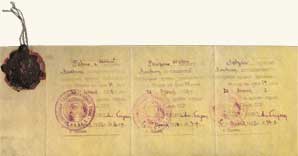 | |
| Рermit for temporary stay in Moscow issued to
N. Roerich’s expedition members. 1926 |
In Urumchi – the capital of the Chinese province of Sin Tsian – Roerich got in touch with Soviet Consul Bystrov. Soon, the permit for entrance into Soviet Russia arrived. Departing from Urumchi, Nicholas Roerich left to the Consul for custody his diary and the last will. The situation in China was tensed, and in the event of the expedition loss, all its property and the paintings were to pass over to the Soviet government.
On May 29, a small expedition group crossed the Soviet border near Zaisan Lake. “Hello, spring land in your new attire!”21 The first meeting with the people of new Russia stunned and inspired. “They come to see us in the evening, and until very late hour, we talk about broadest, the most cosmic problems. Where else is there such border command where one could talk of cosmos and the world evolution?! It fills you with joy.
They ask persistently to show tomorrow the paintings and talk again. At which border post would they speak and think like this?”22
Difficulties and complications faced by Russia in those years, shielded from the Roerichs neither the pathos of creation, nor construction of a new culture, nor formation of new mentality, free from prejudice. “It makes you happy to move along the Irtysh and hear of good construction. It makes you happy not to hear any foul language and not to see vulgar gestures. It makes you happy to see deepening of knowledge”23.
In Moscow, the painter was received by two People’s Commissars: G. Chicherin and A. Lunacharsky. They showed great interest for the expedition, asked questions about the passed way, promised support.
The Roerichs brought to Russia unusual Gifts. A casket with Himalayan earth, a letter of the Teachers to the Soviet people – “Hello to You, searching for the Common Benefit!”, a series of paintings “Maytreya” created by the artist during the expedition, a manuscript of the book “Commune” which the Roerichs wanted to publish in Russia.
“In the letter, the Teachers considered what had been done from the point of view of spiritual and cultural evolution of mankind, L. Shaposhnikova writes. – They considered it integral part of the general evolution of Cosmos. In the manuscript of the book which was brought together with the letter, explanations concerning this Cosmic evolution were contained. <…> and it, beside issues of cosmic character, spoke also about earthly matters related to new Russia and its future. <…> the year of 1926 was that crucial moment when the country faced the choice: either the Common Benefit, or “the darkness of fetishism”. <…> “Commune” was a book-warning”24.
The Gifts were not understood or perceived. The letter from the distant Himalayas got into the archive, the casket with the sacred earth was lost, the hopes for the book publication did not come true. The paintings of the series “Maytreya” given by the painter to the state remained unnoticed. After some time, M. Gorky managed to place them in the art gallery of Nizhniy Novgorod, his native city.
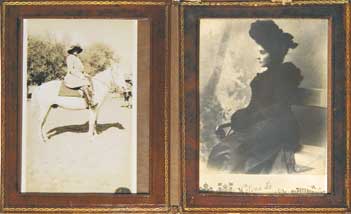 | |
| H. Roerch’s photos belonging to N. Roerich |
From Moscow, the expedition headed for Altai through the whole country. “It is both strange and amazing – all over this territory they praise Altai, the artist wrote. – The mountains are beautiful, the cedars are mighty, the rivers are fast, and the flowers are unseen”25. In the diary, he pointed out the economic significance of Altai: “This construction economy, virgin bowels, radioactivity, herbs higher than a horse-rider, forest, cattle breeding, roaring rivers calling to electrification – all this renders to Altai unforgettable significance!”26
The Roerichs settled down in an Old Believers’ village Verkhniy Uymon, in the house of Vakhramey Atamanov who agreed to be their guide. “He, following the behest of the wise, is not surprised at anything; he knows the ores, knows the marals too, knows the bees, and – the most important and desired – he knows the herbs and flowers”27.
They passed on horseback hundreds of kilometers along mountain stony paths, crossed tumultuous mountain rivers, precipitous canyons.
Helena Roerich overcame all the difficulties together with the men. In the hall show-case, there are two photographs of Helena Roerich: on one she is a young fashionable lady, on the other – expedition participant on horseback. Nicholas Roerich never parted with these pictures.
The Roerichs spent on Altai about a month. They collected minerals, admired petroglyphic drawings. They studies ancient mounds, menhirs – “long stones”, stone statues whose mysterious faces always looked East. Mysterious legends were connected with a white-snow beauty – the mountain of Beloukha. The people’s fantasy was interwoven in them with half-forgotten reality, the wonderful land of Belovodye (White Waters) reminded of Buddhist Shambala, in the image of White Burkhan, Indian Buddha could be guessed. Maybe, he once passed Altai? For Altai and the Himalayas belong to a single mountain system. Through Altai, paths of ancient wanderers and settlers go – “from Tibet through Kuen-Loon, through Altyn-Tag, through Tourphan; the “long ear” knows about the secret passages. How many people escaped to these passages and caves. And reality became a fairy-tale. Same as the black aconite of Himalayas turned into the “Fire-Flower”28. “The snows of Himalayas testify to the snowy peaks of Beloukha”29, Nicholas Roerich wrote afterwards. This is how the idea of the book about the Central-Asian expedition “Altai – Himalayas” was conceived.
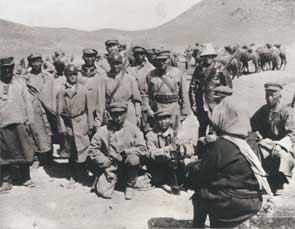 | |
| Expedition participants (from the right)
K. Ryabinin, G. Roerich, L. and I. Bogdanovs. At the foreground, from the back – H. Roerich. 1927 |
In August of 1926, the expedition headed via Biysk for Ulan-Ude, and from there to Mongolia, an ancient and peculiar country.
Urga (now Ulan Bator), the capital of Mongolia, was standing on a plane surrounded with mountains. The roofs of Buddhist temples were sparkling. On the city square, horse-riders of the revolutionary army were galloping – in 1921, five years before the Roarichs’ arrival, a revolution had taken place in Mongolia. “The Mongolian nation is building its light future under the banner of the new age. The Great Horseman of liberation is sweeping above the vast lands of Mongolia…”30 The East was awakening, getting free from many-century oppression, but did not reject the best things kept by its folk traditions. March of 1927 was troublesome for the travelers. Before going out to Tibet, they had to replenish the expedition, to take on reliable guides. While the preparations were under way, Nicholas Roerich managed to establish contact with Lhasa – a mysterious and remote city of Tibet. The Roerichs were allowed to enter Tibet and visit Lhasa.
In April 1927, the expedition left Urga. With difficulties, but without any special adventures, they reached the great desert of Gobi. “Boundless is Central Gobi. White, and pink, and blue, and graphite-black. Whirlwinds are strewing the gentle slopes with a stream of stones. Don’t you get caught in this stony vortex”31.
 | |
| N. Roerich’s bullet-proof vest and a water bag |
They followed an unknown way for Ansi which Russian travelers had not yet taken. The way was dangerous, in the desert, remainders of the gang of robber Jelama, killed two years ago by the Mongols, were scouring. For the purpose of security, all expedition members wore Mongolian costumes, and the guards kept their weapons ready.
It was G. Roerich who was in charge of the caravan security. Before the expedition, he studied at the Paris University Military Department. Not once George Roerich’s tactical skills, far-sightedness, and courage saved the caravan.
On August 19, passage over salinas of Tsaidam started. They had to move on the unstable salt crust. “We are passing the most dangerous road without realizing it. On the sides of a narrow path – there are bottomless holes. A wrong step – and there is no coming back”32. They moved more than a whole day, without stops, until sands started again. At a distance, blue mountains showed, behind which Tibet was.
“We don’t know how Tibet will meet us, Nicholas Roerich wrote. – If Ladakh, called Little Tibet, is beautiful, then the Great Tibet must be extraordinarily majestic. Though, very often the mankind confuses names, and the “little” turns out to be great. Let us see the reality without prejudice and superstitions”33.
Tibet met the travelers with blizzards and wet snow. When the expedition entered the valley of Shendi, it was stopped by a detachment of Tibetan soldiers. They had to make an unplanned camp. The next day, the commander of the detachment which stopped them, and then an important officer from the Governor of Nagchu arrived. The expedition was allowed to pass to neither Lhasa, nor Nagchu. It was arrested and left in summer tents on the high mountain plateau Chantang looking like Arctic tundra.
![N/ Roerich. Chantang. Tibet [Tibetan Camp]. 1943](/upload/picture_chantang.jpg) | |
| N. Roerich. Chantang. Tibet [Tibetan Camp]. 1943 |
Nicholas Roerich attempted to get in touch with Lhasa, but his messengers left and never showed up again. “The situation was becoming desperate, the painter wrote in the book “The Heart of Asia”. – A severe winter started, at the height of fifteen thousand, with whirlwinds and snows. What and where happened, we could not decide, but the letters sent by us to the Dalai Lama and the Governor to Nagchu, came back, often in a torn up state. <…> we were forbidden to move either forward or back, as if someone wanted our death. Our money was coming to an end. <…> We were running out of medicine, running out of food. The caravan was perishing before our eyes. <…> Even local people could not stand the severe conditions. And our caravan was staying in summer tents <…>”34.
On one of Roerich’s sketches – “Chantang. Tibet” – we see tents covered with snow in the middle of deep snowy stillness. At a distance, at the background of violet sky, mountains are standing pinkish in a frosty haze.
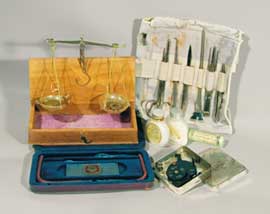 | |
| Medical equipment from the expedition first-aid kit |
The frosts reached 60 degrees by Celsius, hurricane winds were blowing, cognac in the first-aid kit got frozen. The notes say: “H.R.’s pulse reached 145, and our doctor added; “This is the pulse of a bird”. My pulse instead of the usual 64 was 130. <…> The doctor predicted the most gloomy prospects, and wrote medical certificates that arrest under such conditions was equal to organized attempt on a murder”35.
In the show-case, there is Ryabinin’s book with a photograph “The dying caravan” (photo)
The unseemly activities of the Intelligence Service and the Government of British India were already mentioned before, they were directed at preventing the expedition from continuing its way and creating obstacles for its return to India. Representatives of the English Intelligence Service and the colonial authorities of India did everything possible not only to ruin the expedition, but to kill its participants as well.
 | |
| N. Roerich with Shambala thanka. Mongolia. 1927 |
Five awful months lasted the “Tibetan stay” of Roerich’s Central-Asian expedition. A few people died, caravan animals perished. But not for a single day was the scientific work interrupted. Despite the severe winter, they managed to preserve most of their collections, notes, and paintings. The expedition participants’ power of spirit proved to be stronger than the natural element and the evil.
In March 1928, the expedition was allowed to move to Sikkim – through the Trans-Himalayas, through the area of the Great Lakes, to the Brahmaputra, and further, over the pass Sepo La. It was a difficult unexplored way, where unknown passes, not yet marked on maps, rose up to six thousand meters.
The expedition was moving over deep areas of Tibet. Everything was bearing the stamp of decline and decay. “Only the ruins of old Tibet are interesting, Nicholas Roerich noted. – These ancient towers and walls were laid by some other people. Their builders knew both about Gesser-Khan and the Lord of Shambala. There were also the Great Mahatmas’ Ashrams here. But now nothing is left of that” 36. “The principles of life are destroyed. Not us, but Tibetans themselves noticed it. They realize that without contacts with other countries, in the situation of insufficiency of its own spirit, Tibet excludes itself from the modern evolution”37.
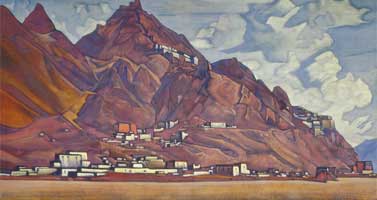 | |
| N. Roerich. Shekhar-Dzong. Undated |
They passed the area of the Great Lakes, overcame the passes Ta-Mar and Nagra-La. “Mighty ridges, dozing under the canopy of a thick violet haze, suddenly were lit with the rising sun, and the rocks played with red, crimson, and violet colors <…>, George Roerich wrote down. – It was the welcome of Trans-Himalayas, the Northern accesses to which the caravan has reached”38.
Passes Mari-Tang-La, Dzegong-La, ancient settlements Tangri-Dzong, Shekhar-Dzong, Kampa-Dzong… “From where does this extraordinary attractiveness of Asian ways come? – Roerich would write later. – The mountains have established themselves not like barring giants, but like calling landmarks. The radiance of the Himalayan snowy kingdom is sparkling from behind the peaks. The local people, those who heard of something, respectfully point at this radiance. Because it sparkles from labor, from the very tower of great Rigden-Japo tirelessly working for the benefit of mankind”39.
Having overcome the last pass Sepo-La, the travelers approached Sikkim, and on May 24, they entered its capital Gangtok. No expedition caravan had ever passed the way from Ulan Bator to Sikkim along such itinerary.
19N. Roerich. Altai – Himalayas. – М.: RIPOL CLASSIC, 2004. – p. 133.
20N. Roerich. The Power of Light. – М.: Exmo, 2005. – p. 167.
21N. Roerich. Altai – Himalayas. – М.: RIPOL CLASSIC, 2004. – p. 245.
22Same. – p. 246.
23Same. – p. 252.
24L. Shaposhnikova. Wisdom of Centuries. – М.: ICR, 1996. – p. 100, 116.
25N. Roerich. Altai – Himalayas. – М.: RIPOL CLASSIC, 2004. – p. 221.
26N. Roerich. The Heart of Asia. – S-Pb., 1992. – С. 23.
27N. Roerich. Altai – Himalayas. – М.: RIPOL CLASSIC, 2004. – p. 258.
28N. Roerich. Altai – Himalayas. – М.: RIPOL CLASSIC, 2004. – p. 256.
29Quotation after: L. Shaposhnikova. From Altai to the Himalayas: Along the Itinerary of N. Roerich’s Central Asian Expedition. – М.: ICR, 1998. – p. 17.
30Quotation after: L. Shaposhnikova. Great Travel. – Book 1. Master. – М.: ICR, 1998. – p. 261.
31N. Roerich. Altai – Himalayas. – М.: RIPOL CLASSIC, 2004. – p. 271.
32N. Roerich. Altai – Himalayas. – М.: RIPOL CLASSIC, 2004. – p. 275.
33N. Roerich. Altai – Himalayas. – М.: RIPOL CLASSIC, 2004. – p. 268.
34N. Roerich. The Heart of Asia. – S-Pb., 1992. – p. 35.
35Same.
36N. Roerich. Altai – Himalayas. – М.: RIPOL CLASSIC, 2004. – p. 282.
37N. Roerich. Shambala. – М.: ICR, 1994. – p. 56.
38Quotation after: L. Shaposhnikova. Great Travel. – Book 1. Master. – М.: ICR, 1998. – p. 286.
39N. Roerich. Держава света. М.: Эксмо, 2005. – С. 344.
|
|
||
|
||